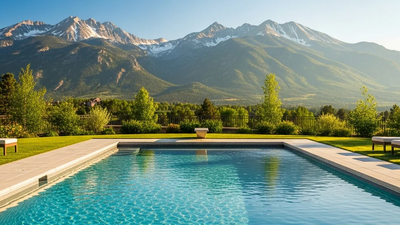
Managing a swimming pool in Alaska presents unique challenges that make ownership financially overwhelming for most homeowners. Understanding these costs and finding smart solutions is essential for anyone considering pool ownership in the Last Frontier.
The Reality of Alaska Pool Ownership
Alaska pool owners face a perfect storm of challenges that transform the dream of backyard swimming into a financial nightmare. With electricity costs reaching $0.29 per kilowatt-hour in cities like Cordova and heating oil at $3.50 per gallon, the operational expenses dwarf those experienced in temperate climates.
The harsh reality becomes clear when examining real data from Alaska's municipal facilities. The Bob Korn Memorial Swimming Pool in Cordova demonstrates the immense energy demands required to maintain pool operations in Alaska's climate. This public facility's energy consumption provides a sobering preview of what residential pool owners can expect on a proportional scale.
Understanding Alaska's Extreme Pool Maintenance Costs
The Energy Crisis Challenge
Alaska's energy costs create an immediate barrier to affordable pool ownership. The state's "rural conundrum" means many communities face exceptionally high energy prices that make heating and filtration systems prohibitively expensive. The City and Borough of Juneau has officially recognized high energy costs as a community-wide challenge , highlighting how widespread this issue has become.
Comparative Maintenance Expenses
Even in moderate climates, pool maintenance represents a significant investment. Basic annual pool maintenance typically costs between $1,200 and $1,800 , but these figures can escalate to $3,000-$5,000 when heating and repairs are included . Pool ownership guides suggest annual maintenance costs ranging from $500 to $4,000, with an average around $1,500 .
Canadian pool owners, facing somewhat similar northern conditions, report costs ranging from $500-$800 for unheated pools to thousands of dollars for heated facilities . These baseline figures underscore the financial commitment required before even considering Alaska's unique challenges.
Climate-Specific Heating Challenges
Advanced Heating Requirements
Alaska's extreme temperature differentials demand sophisticated heating solutions. While traditional heat pumps lose efficiency in cold temperatures, ground source heat pumps maintain higher efficiency in cold climates . However, these systems require substantial initial investment costs that many homeowners find prohibitive.
Hybrid systems combining heat pumps with solar heating can reduce overall energy consumption , but the 2022 heat pump pool heating cost-effectiveness report indicates that even in milder climates, annual electricity costs remain significant . In Alaska's environment, where heating seasons are prolonged and temperature differentials extreme, these costs multiply substantially.

Smart Solutions for Alaska Pool Owners
Revolutionizing Pool Maintenance Efficiency
The key to managing Alaska pool costs lies in maximizing operational efficiency while minimizing energy waste. Traditional manual cleaning methods prove both labor-intensive and energy-wasteful in Alaska's challenging conditions. Smart automation becomes not just convenient but financially essential.
iGarden's K Series Pool Cleaners offer Alaska pool owners a game-changing solution with their 6-hour single-charge runtime and AI scheduling cleaning capabilities. The intelligent navigation system ensures thorough cleaning while minimizing energy consumption – a critical factor when electricity costs $0.29/kWh.

Addressing Extreme Debris Challenges
Alaska's unique environment creates debris challenges unknown in temperate climates. Wind-blown particles, seasonal organic matter, and weather-related contamination require powerful cleaning solutions that won't drain already strained energy budgets.
The iGarden K Pro Pool Cleaner specifically addresses these concerns with its 15-hour runtime and Turbo 200% enhancement mode. This advanced cleaning power tackles stubborn stains and heavy debris that would otherwise require expensive chemical treatments or professional services – costs that Alaska pool owners simply cannot afford to accumulate.
Strategic Cost Management Approaches
Seasonal Operation Planning
Alaska pool owners must develop sophisticated seasonal strategies to manage costs effectively. Extended winter shutdown periods can significantly reduce heating expenses, but proper preparation and restart procedures become critical for equipment longevity and water quality maintenance.
Automation as Financial Necessity
In Alaska's high-cost environment, automation transforms from luxury to necessity. Efficient robotic cleaning systems reduce manual labor requirements while optimizing cleaning cycles to operate during off-peak energy periods. This strategic approach can significantly impact overall operational costs when every kilowatt-hour carries premium pricing.
Long-Term Financial Planning
Investment vs. Operational Costs
Alaska pool owners must carefully balance initial equipment investments against long-term operational savings. While premium cleaning systems require upfront investment, their efficiency gains become amplified in Alaska's high-cost energy environment. The ability to reduce cleaning time, minimize chemical usage, and optimize energy consumption creates compounding savings over time.
Community Resource Sharing
Given Alaska's unique challenges, pool owners often benefit from community-based approaches to cost management. Bulk chemical purchases, shared equipment maintenance resources, and coordinated seasonal preparation can help distribute the high costs of Alaska pool ownership across multiple households.
The Path Forward for Alaska Pool Owners
Successfully managing a pool in Alaska requires accepting that traditional cost models simply don't apply. The combination of extreme climate conditions and high energy costs creates a unique operational environment that demands innovative solutions and strategic planning.
Smart automation, efficient cleaning systems, and careful seasonal management can transform an otherwise financially prohibitive venture into a manageable luxury. However, this requires commitment to advanced technology and strategic operational planning that goes far beyond typical pool ownership approaches.
Alaska pool owners who succeed understand that every operational decision carries amplified financial consequences. Choosing efficient, automated solutions isn't just about convenience – it's about making pool ownership financially sustainable in one of the most challenging environments in North America.
The dream of Alaska pool ownership remains possible, but only for those willing to invest in the smart technology and strategic approaches necessary to overcome the state's unique challenges. With proper planning and efficient systems, the costs that initially seem prohibitive can be managed through intelligent automation and operational excellence.








